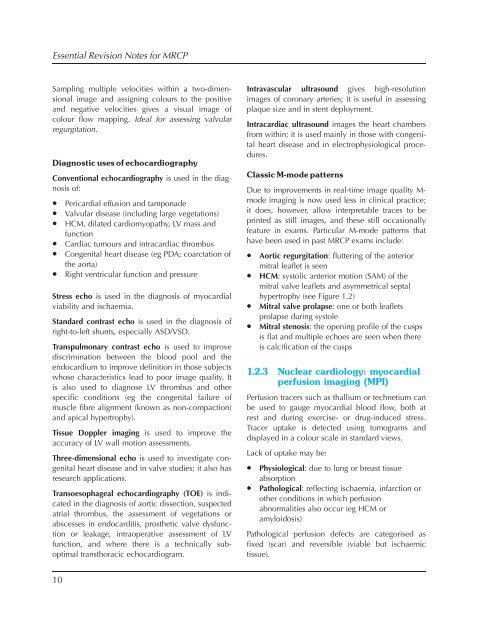Essential Revision Notes for MRCP Third Edition - PasTest
Essential Revision Notes for MRCP Third Edition - PasTest
Essential Revision Notes for MRCP Third Edition - PasTest
- No tags were found...
Create successful ePaper yourself
Turn your PDF publications into a flip-book with our unique Google optimized e-Paper software.
<strong>Essential</strong> <strong>Revision</strong> <strong>Notes</strong> <strong>for</strong> <strong>MRCP</strong>Sampling multiple velocities within a two-dimensionalimage and assigning colours to the positiveand negative velocities gives a visual image ofcolour flow mapping. Ideal <strong>for</strong> assessing valvularregurgitation.Diagnostic uses of echocardiographyConventional echocardiography is used in the diagnosisof:• Pericardial effusion and tamponade• Valvular disease (including large vegetations)• HCM, dilated cardiomyopathy, LV mass andfunction• Cardiac tumours and intracardiac thrombus• Congenital heart disease (eg PDA; coarctation ofthe aorta)• Right ventricular function and pressureStress echo is used in the diagnosis of myocardialviability and ischaemia.Standard contrast echo is used in the diagnosis ofright-to-left shunts, especially ASD/VSD.Transpulmonary contrast echo is used to improvediscrimination between the blood pool and theendocardium to improve definition in those subjectswhose characteristics lead to poor image quality. Itis also used to diagnose LV thrombus and otherspecific conditions (eg the congenital failure ofmuscle fibre alignment (known as non-compaction)and apical hypertrophy).Tissue Doppler imaging is used to improve theaccuracy of LV wall motion assessments.Three-dimensional echo is used to investigate congenitalheart disease and in valve studies; it also hasresearch applications.Transoesophageal echocardiography (TOE) is indicatedin the diagnosis of aortic dissection, suspectedatrial thrombus, the assessment of vegetations orabscesses in endocarditis, prosthetic valve dysfunctionor leakage, intraoperative assessment of LVfunction, and where there is a technically suboptimaltransthoracic echocardiogram.Intravascular ultrasound gives high-resolutionimages of coronary arteries; it is useful in assessingplaque size and in stent deployment.Intracardiac ultrasound images the heart chambersfrom within; it is used mainly in those with congenitalheart disease and in electrophysiological procedures.Classic M-mode patternsDue to improvements in real-time image quality M-mode imaging is now used less in clinical practice;it does, however, allow interpretable traces to beprinted as still images, and these still occasionallyfeature in exams. Particular M-mode patterns thathave been used in past <strong>MRCP</strong> exams include:• Aortic regurgitation: fluttering of the anteriormitral leaflet is seen• HCM: systolic anterior motion (SAM) of themitral valve leaflets and asymmetrical septalhypertrophy (see Figure 1.2)• Mitral valve prolapse: one or both leafletsprolapse during systole• Mitral stenosis: the opening profile of the cuspsis flat and multiple echoes are seen when thereis calcification of the cusps1.2.3 Nuclear cardiology: myocardialperfusion imaging (MPI)Perfusion tracers such as thallium or technetium canbe used to gauge myocardial blood flow, both atrest and during exercise- or drug-induced stress.Tracer uptake is detected using tomograms anddisplayed in a colour scale in standard views.Lack of uptake may be:• Physiological: due to lung or breast tissueabsorption• Pathological: reflecting ischaemia, infarction orother conditions in which perfusionabnormalities also occur (eg HCM oramyloidosis)Pathological perfusion defects are categorised asfixed (scar) and reversible (viable but ischaemictissue).10
















